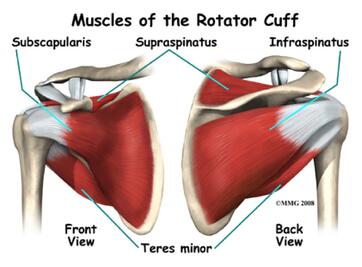Shoulder Care: The Rotator Cuff
In this post I want to go over the basic anatomy of the rotator cuff, the functions of its parts, and some exercises that can help strengthen your shoulder stabilizers to keep your shoulders healthy. The shoulder tends to be a problem with not only athletes but in the general population as well. The shoulder is one of the most mobile joints we have, so when we are working up the kinetic chain we want to work on its overall stability so that we can protect it from injury.

Anatomy of the Shoulder
First and foremost, the rotator cuff is a group of tendons and muscles in the shoulder connecting the upper arm (humerus) to the shoulder blade (scapula). The rotator cuff’s main purpose is to hold the head of the humerus in the glenoid (shoulder) cavity. Below are the rotator cuff muscles and their main functions.
The muscles in the rotator cuff include the following:
- Supraspinatus: Abducts the shoulder in the first 30 degrees.
- Infraspinatus: External rotation.
- Teres minor: External rotation.
- Subscapularis: Internal rotation.
You can remember these using the acronym SITS.
Exercises for Shoulder Stability
Now that you have a basic understanding of the shoulder’s anatomy and functions, let’s go over exercises that help improve strength and overall stability of the shoulder.
Supraspinatus (Abduction)
Infraspinatus and Teres Minor (External Rotation/ER)
Subscapularis (Internal Rotation/IR)
Grip Strength and Stability
Performing exercises that challenge your grip strength is another great way to improve the stability in the shoulder. These exercises target the entire shoulder instead of focusing on one muscle. Examples here include KB bottoms up variations such as half kneeling single-arm bottoms-up press or bottoms up walk.
Programming
As a strength coach, I deal with overhead and throwing athletes on a daily basis, so keeping the shoulders healthy is a big part of my job. My goal is always to keep the shoulders healthy and strong instead of waiting until they are completely out of competition due to injury. Shoulder care exercises are not just for throwing athletes. These exercises can benefit all athletes and should be integrated into your weekly training program.
The biggest concern that I deal with on a daily basis is fighting overuse injuries. Overuse injuries account for most of the shoulder injuries, and so I have to find a balance to keep their shoulders healthy. My pitchers are required to do some sort of shoulder care each day that they are in. This past year my pitchers were doing mostly supraspinatus strengthening and everyone else did more external and internal rotation exercises.
Depending on what is in your workout for the day, you can complete these either before or after the strength portion of your workout. If you have pressing, pulling, or any overhead exercises, they should be done first to activate the shoulder musculature to reduce the chance for injury. If it is more of a lower-body workout, you can finish your workout with some shoulder care exercises.
Hopefully you now have a good understanding of the importance of shoulder care, the benefits of strengthening your rotator cuff, and how to implement these exercises so that your shoulders can feel better than ever.
This blog was written by trainer Josh Jones, MS, CSCS, USAW, NIFS Center for Athletic Performance. Read more about the NIFS bloggers here.
